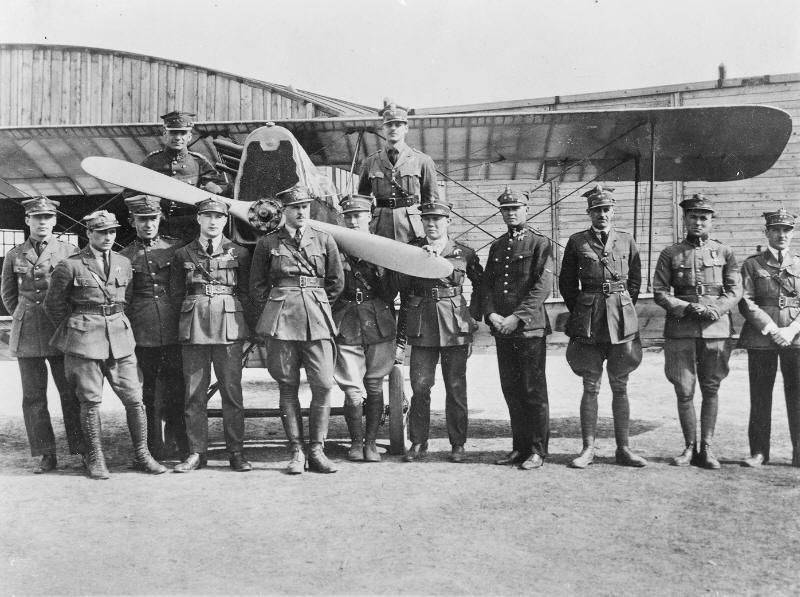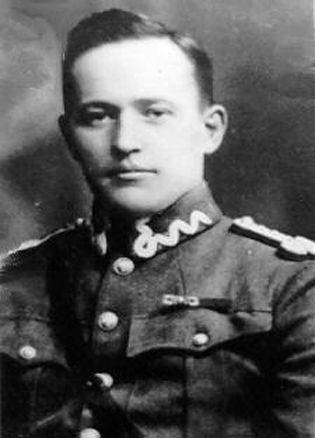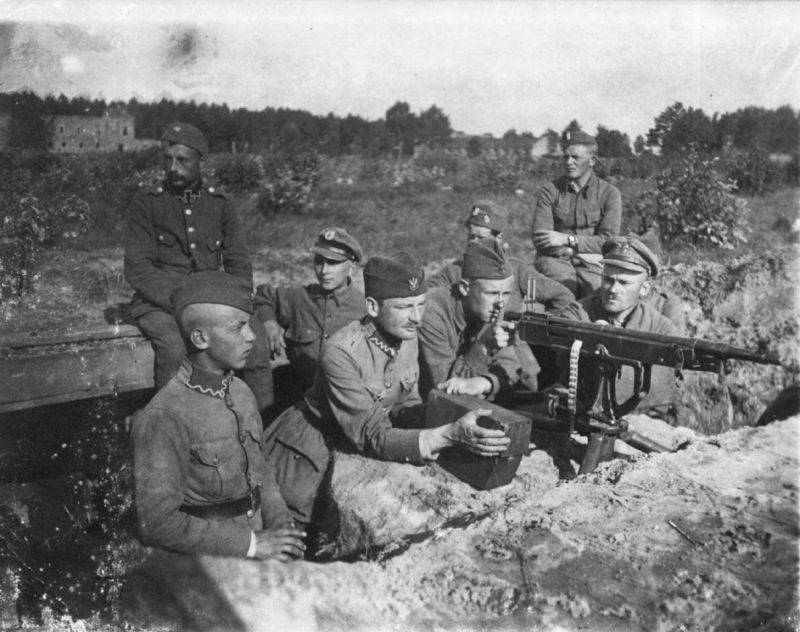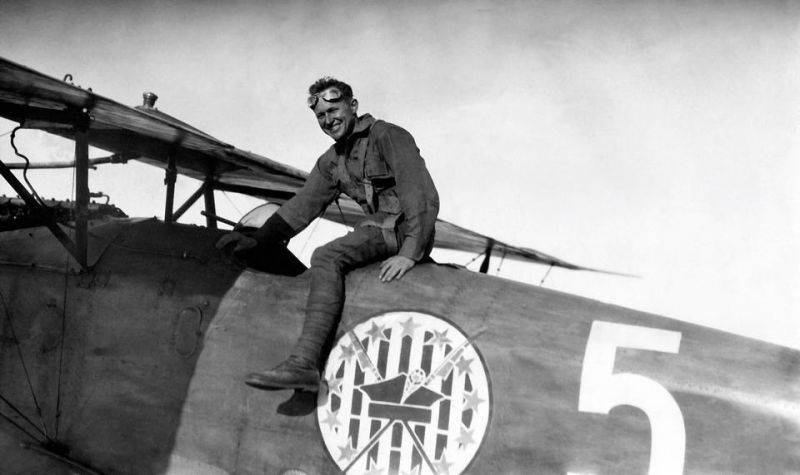American pilots in the Soviet-Polish war
In many ways, the political fate of Poland was predetermined by the fact that already in 1915, the Russian army was forced to retreat from the Vistula to the east. As a result, the whole territory of Poland was under the control of the Germans. In November, 1918, after Germany capitulated, power over Poland automatically passed into the hands of Jozef Pilsudski. This man was a Polish nationalist who had been engaged in anti-Russian struggle for a quarter of a century. Since the beginning of the First World War, he personally engaged in the formation of the "Polish Legions" - special volunteer detachments who fought as part of the forces of Austria-Hungary. It was the “legionaries” after the end of the First World War that became the basis for the new Polish government, and Pilsudski himself received the official title of “Head of State”, became a dictator.
At the same time, a new state headed by a dictator was immediately supported by the victor countries in the First World War, first of all France and the USA. France hoped that it would be possible to make a counterbalance from Poland as a defeated, but not resigned to its defeat Germany, and Russia, in which the power of the Bolsheviks, incomprehensible and dangerous for the elites of Western European countries, came to power. In Washington, for the first time, they were able to realize their own increased power and saw in independent Poland a convenient excuse to try to spread their own influence in the very center of Europe.
Poland itself was thinking only about how to grow with new lands. Germany lying to the west, although it capitulated in the First World War, didn’t seem appetizing at all. German officers and soldiers who defeated 4 of the year could well question the very existence of a new state. Another thing is the eastern lands, where a new Soviet Russia appeared, which, probably, did not know then how many fronts it had. Moreover, peasant rebellions continually arose in its provinces. It was in the east and the UPR - the Ukrainian People's Republic, which is constantly decreasing in size. Her head sat out not in Vinnitsa, not in Zhytomyr. While across the expanses of Ukraine, hastily moved together groups of Bolsheviks and up to two dozen large gangs headed by atamans moved. From the point of view of Poland, these lands were abandoned at that moment, and she began to rake them up for herself.
Already in the 1919 year, Poland seized part of Belarus, and at the same time liquidated ZUNR (the Western Ukrainian People's Republic), and already on 25 on April 1920 of the year began the Kiev operation. At the same time, in Warsaw, they began to draw maps of the new Poland, with the inclusion of Belarus, Ukraine, and also Latvia, Lithuania, and Estonia (within the borders of the Polish-Lithuanian Commonwealth 1772 of the year). In a conversation with an English diplomat, McKinder, Jozef Pilsudski said quite seriously that he was not planning to take Moscow, because he didn’t know what to do with it further.
The West really supported Poland in this expansion to the east. So only one France supplied the Polish army with 1920 327 thousands of rifles, 2600 machine guns, 1500 guns, 290 airplanes and 250 vehicles during the year. But any military equipment without a person is dead, and an army without competent officers is just an armed crowd of people. Therefore, the General Staff of the Polish Army sounded French as often as the Polish. Helped Poland and the USA with Great Britain. Washington, in addition to the implementation of military supplies, also decided to strengthen the Polish Air Force. As a result, an entire squadron made up of American volunteers took part in the Soviet-Polish war.
Just so on the horizon stories there was a figure of Merian Cooper. This man was clearly not born for a quiet life. Enrolling at the naval academy in his time, he rather soon abandoned it, devoting himself to journalism. Flooding, shootout, fire - Merian Cooper was always in the middle of the action. However, the adrenaline at this job he was clearly not enough. So in 1916, 23-year-old Cooper finds himself on the US-Mexican border as part of the National Guard, battling with Pancho Villa's troops. And in 1917, he successfully completed flight courses and, as part of the American expeditionary force, went to Europe to take part in the First World War. During one of the air battles, his plane was shot down, and the pilot himself was captured. In November 1918, after the capitulation of Germany, Cooper regained his freedom. However, Merian Cooper did not go back to quiet America. His blood continued to seethe, and in Europe, even after the end of World War I, there were enough hot spots.
In the spring of 1919, the former fighter pilot, Captain Merian Cooper, who gained combat experience during battles in the skies of France, finds himself in southern Poland in search of work and offers. Initially, he was attracted to the creation of a charter airline, but when Cooper saw how hard the process of formalizing Polish independence was going on, he decided to take up help. His plan was to create a volunteer fighter squadron of the type aviation Lafayette Squadron in 1916. To do this, Cooper immediately went to Paris, where he began the process of recruiting his former “wing colleagues”. His first assistant was Cedric Fountleroi, who in the future also “broke through” the official permit for the recruitment of American citizens wishing to serve in Polish aviation.

Already in September, the first American pilots, who were recruited by Cooper, arrived in Ukraine under Lviv 1919. Pilots (and there were about 20 people) were taken to the ambulance, like soldiers suffering from typhus. According to the previously agreed status, all American pilots were reduced to one fighter squadron, which was to be used exclusively for military operations. In this case, the staff and mechanics in the squadron were Polish. The command of the American squadron was taken over by Major Cedric Fauntleroy. All American pilots had a good level of training, so the Polish command immediately transferred the squadron to the territory of Western Ukraine.
31 December 1919, the 7 th combat squadron was named after Tadeusz Kosciuszko, a Polish patriot who fought with George Washington during the US independence war. The pilots of this squadron spoke English. However, all the pilots wore a Polish uniform, although their present citizenship was no secret to anyone. “Patients with typhus” didn’t hide it themselves, and in the squadron emblem one could easily guess elements of the American flag. Moreover, this unit was often visited by the US envoy to Poland, Hugh Gibson, who was even awarded the title of “Honorary Squadron Member”.
For the first time, American pilots took part in the Soviet-Polish war during the Kiev offensive in April 1920, when part of them moved from the Lviv airfield to the Polonne field site. At that time, the squadron was armed with several old "Albatros" D.III (Oef) (the Poles still inherited from Austria-Hungary), as well as several Ansaldo fighters A.1 Balilla just received from Italy. From the new airfield, American pilots made several dozen combat missions against units of the Red Army. Bombing and assault strikes made from low altitudes became a favorite tactic for pilots. At the same time, the field commanders of the Polish troops highly appreciated the effectiveness of such air strikes. For example, the commander of the 13 Infantry Division, General Puchutsky, wrote in his report: “American pilots are fighting with great courage. During the last offensive, their commander one attacked enemy units from the rear, dropping machine-gun rain on the heads of the enemies. Without American air assistance, we could hardly have maintained the pace of the attack. ”
From the beginning of the Kiev operation of the Polish troops, American pilots destroyed bridges, bombed railway stations, attacked the positions of the Red Army men. They bombed the cities of Zhytomyr, Radomyshl, Berdichev, and Cherkasy. As the Polish troops moved further east, the base position of the 7 squadron also shifted. At the end of May 1920, the American pilots were already under the White Church. The American pilots made several sorties every day for reconnaissance purposes, but they “missed” the approach of the main units of the First Cavalry Army of Budyonny. Only 25 in May 1920, one of the pilots noticed a large convoy of escorts, but it was too late.

Budenovtsy were able to break through the Polish front. The retreat of the Polish army began, which at times resembled just flight. Now 7 squadron named Kosciuszko was forced to move back to the west, but it had to be done much faster. From the airfield, located under the White Church, the American pilots managed to fly literally at the very last moment, already to the hum of hooves and Horse Guards “Give!”. At the same time 3 airplanes, which simply did not start the engines, the Americans had to burn. The squadron landed in Berdichev, however, and from there they had to carry their feet. At the same time, the 2 of the faulty airplanes this time did not even have time to burn. Under Fastov, the squadron members were nearly captured again along with their aircraft. As a result, they still survived, but they threw the entire stock of ammunition and equipment.
Then, along with the 9 of the Polish squadron, the American pilots settled under Kazatin, from where they made combat missions to the Ruzhin and Lipovets districts. American pilots threw food and ammunition to the Polish troops there, accompanied the retreating Polish units, and bombed the pontoon ferries of the Bolsheviks. However, the respite that emerged here was short-lived. Already 6 June Budenovites once again managed to break through the front, and the Yankees again managed to escape only by a miracle. The squadron commander Fauntleroy, threatening with his pistol, literally “tore out” railway platforms for his planes. At the same time, the pilots of the 9 of the Polish squadron simply fled, leaving their airplanes to Budenovskim.
Not done in the actions of the Americans and without downed pilots. So 26 July 1920, the captain Merian Cooper, who was captured, was shot down. He spent about 9 months in captivity in a Soviet prisoner of war camp. Here he met with Soviet writer Isaac Babel. After an unsuccessful escape attempt, Cooper was sent to build a railroad near Moscow, from where he escaped again and was able to return to Poland through the territory of Latvia and Lithuania. At the same time, Merian Cooper, who was in reality the son of a famous lawyer and landowner from Florida, was taken prisoner as a simple American proletarian worker who ended up in this war under duress. They helped to confirm his proletarian origin and burnt hands, he received burns when he was shot down at the front in France. One way or another, his legend of proletarian origin saved his life.
The activity of American pilots in the Soviet-Polish war reached its climax at the turn of August-September 1920 during the defense of Lviv. At the same time, Fauntleroy was appointed commander of the entire aviation of the 6 Polish Army, and under his start came new American pilots who reinforced the existing Polish squadrons. As a result, under the command of the American lieutenant colonel were all the air force, which at that time acted against the Soviet South-Western Front.
During this period, every American pilot flew from 4 to 5 per day. Budyonny reported that his units were subjected to air attacks at least three times a day. So only 6-I cavalry division during the day of August 17 from enemy air attacks killed and wounded 100 order of their fighters and the same number of horses. Due to the strong opposition of enemy aircraft, the offensive was halted by the division. And in the order of the Polish Chief of Staff T. Rozwadowski from 1 September 1920, it was said that only for two days on August 16-17, the squadron commanded by Fauntleroy executed 127 combat sorties, dropping 7700 kg of bombs and izs from iz of enemy groups and throwing X-NUMX sorties, dropping XNUMX combat sorties to the enemy, and throwing XNUMX combat missions, and drop of iz and ihs from iz, and of fragments of iNFXs. ammunition. At that time, these numbers were simply huge. After the defense of Lviv, American pilots managed to take part in the Battle of Warsaw and the Battle of Komarov.
It is worth noting that at that time the Soviet authorities were not aware of the broad participation of American pilots in the war on the side of Poland. This became known later from their memoirs and studies of Western historians. For example, N. Davis, who also turned his attention to the fact that the Polish-Soviet war demonstrated the need for the further development of aviation. “For the first time in the history of wars, airplanes have shown what they can really be capable of. They became the real eyes of the army. The superiority of the Poles in the air was one of the reasons that the Polish army often avoided dangerous clashes for themselves, ”the researcher wrote. At the same time, in the offensive, the role of aviation increased significantly.
The war for American pilots ended in May 1921, but some of them remained in Poland and served for some time as part of the Air Force of this country. According to the results of the war, Cooper and Fauntleroy were awarded the highest Polish military award from the hands of Jozef Piłsudski - Virtuti Militari. Subsequently, Merian Cooper returned to the United States, where he became one of the founders of the famous airline Pan American, leaving a mark in aviation history. In addition, he even became interested in cinema. For example, the famous film "King Kong" 1933, was filmed by Cooper, who generally could not return to his home from the Soviet-Polish war.
Information sources:
http://ertata.ru/post322903278
http://rusplt.ru/world/sovetskopolskaya-voyna-1920-goda-18762.html
http://maxpark.com/community/14/content/1711033
http://warspot.ru/242-amerikanskiy-sled-v-sovetsko-polskoy-voyne


Information